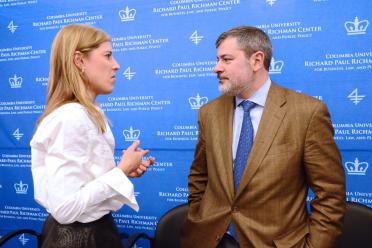
On November 13, 2018, the Richard Paul Richman Center for Business, Law, and Public Policy at Columbia University hosted a panel discussion on business, investing strategy, and geopolitics in the Middle East. The interdisciplinary panel of experts was comprised of John Balouziyeh, Senior Legal Consultant at Dentons; Jason Bordoff, Professor of Professional Practice in International and Public Affairs at Columbia University; and Aamir A. Rehman, Partner at Hoopoe Capital and Senior Fellow at the Richman Center, with Dr. Alexis Crow, Geopolitical Investing Lead at PwC and Senior Fellow at the Richman Center, serving as moderator.
While scarcely a week passes without geopolitical activity in the Middle East making headlines, the panelists deployed their respective expertise to move beyond day-to-day news to explain the underlying dynamics of the region and the impact they have on investing strategy. The standing-room-only crowd for this discussion underscored the importance of this topic to academics, students, and industry leaders alike.
Continued Significance of Oil
Professor Bordoff led the panel with a discussion of oil price volatility and its impact on overall economic diversification. Despite the decline in oil prices since 2014, Bordoff emphasized that energy investors should examine trends in natural gas and shale supply alongside any changes in oil prices. Recent estimates of decreased oil demand, coupled with an increase in US shale and oil production, are the latest developments in a series of trends suggesting that oil-rich states should continue to diversify their economies beyond oil.
For example, the natural gas market is experiencing a historic and rapid transformation in distribution, led by the industry’s transition from pipelines to shipping tankers as the primary method of gas transportation. This method of transportation can avoid many of the geopolitical risks historically associated with pipelines. While diversification away from hydrocarbons is ultimately a path forward for Middle Eastern exporters, the emergence of China as the world’s largest importer of natural gas—as well as forecasts that India will surpass China as the world’s largest consumer of oil by 2035—indicate that the lifeblood of some of these countries is by no means endangered.
The panelists agreed that the age of oil is far from over, but noted that the current period of low growth in the industry is fostering sustainable financial practices across the Middle East, including the Value Added Tax introduced across the Gulf Cooperation Council (GCC) states. Balouziyeh provided firsthand insight from his years in Riyadh on this topic, explaining that while the downturn in energy prices since mid-2014 has spurred a wave of reforms, Saudi Arabia has long promoted diversification programs that will enable government services to continue supporting a population of over 26 million people. These programs include a public-private partnership law to encourage domestic manufacturing and creation of goods, as well as attempts to attract foreign investment through more favorable arbitration policies.
Regional Dynamics Across the Middle East
Rehman next described the power dynamics of the Middle East across discrete regions and the subtleties of investing in these regions. From the Maghreb nations (Morocco, Tunisia, Libya, and Algeria) and moving east across Egypt, Levantine states (Iraq, Lebanon, Syria), Jordan, Palestine, and the GCC, companies are developing country-specific investment and operation strategies. Rehman stressed that these strategies must be tailored to fit the unique business ecosystem in each country to capitalize on growth and achieve a faster payout. While part of the business case behind the GCC is forming a common market and scale for potential investors, a multinational corporation would need to considerably adapt its go-to market strategy if it chooses to invest in Egypt, which has twice the population of the entire GCC and a unique dialect, culture, and national history.
Speaking from a GCC-centric view, Balouziyeh underlined the significance of Dubai’s attractive business environment. Dubai offers a flat tax rate, multiple free trade zones, and limited liabilities. Moreover, the emirate allows companies to be wholly foreign-owned. These regulations enable investors to not only set up shop in Dubai, but to also make the city a launch pad for investment in the Middle East, Africa, and Asia. The ease of transportation across ports in the United Arab Emirates (UAE) makes it easier for multinational corporations to base operations in Africa or India while retaining the convenience of operating under British law instead of varying local legal structures.
Economic Diversification and Innovation
When prompted to discuss innovation in the region, the panelists discussed the potential benefits and risks of establishing commercial ties between Middle Eastern states and Israel. Rehman described the benefits of matching Israel’s innovation in pharmaceuticals and technology with population centers across the Middle East. He emphasized that despite the drive for economic diversification, many barriers remain to developing private sector innovation. Public sector jobs boast manageable working hours and lucrative salaries, rendering it difficult for private companies to compete in terms of packages. Countries across the region thus face challenges to create incentives to encourage individuals to enter the private sector instead of pursuing a public sector career.
On a trading level, the Arab League has recently relaxed strict boycott laws against Israel, which may serve as an opportunity for closer partnerships in the future. While there is potential for partnerships to foster innovation, investors need to overcome many geopolitical complications to rely on collaboration between Israel and the rest of the Middle East.
Regarding diversification in Saudi Arabia, Balouziyeh pointed to key policies that the government has pursued to create revenue streams in unconventional sectors. For example, plans to build the $500 billion business city of Neom at the intersection of the Sinai Peninsula, Jordan, Israel, and Saudi Arabia would not only attract foreign investment but could also serve as a source of tourism revenue. Balouziyeh noted that renewable energy—and solar energy in particular—may be of special interest to Saudi Arabia as a way to maximize oil quantities that can be sold abroad. Despite being surrounded by conflict and potential threats on its borders (Bahrain, Yemen, Syria, Gulf of Africa, and Iran, to name a few), the country has remained a stable business environment and powerful political force in the region.
When asked, hypothetically, where to invest a $100 million, excluding energy markets, the panelists’ range of responses highlighted the diversity in opportunities across sectors. Rehman focused on consumer-driven industries, including healthcare, retail and consumer goods, and education. Given the nuanced ecosystems within each nation, he indicated that known operators in each industry could become national champions to spread best-in-class practices across the region. Examples of these opportunities include hypermarkets and entertainment, which can be seen in AMC’s recent expansion into Saudi Arabia.
Balouziyeh concentrated on the potential for growth in real estate across the GCC and Egypt, as property prices are steadily rising. Conversely, Bordoff doubled down on energy investments, underlining the power of low-cost oil resources. He stated that movements away from oil reliance will occur over a long-term horizon and require trillions of dollars in investments. In the long run, he argued that renewable energy represents a great source of potential growth across the Middle East.
This conversation sparked a discussion of potential business and investment opportunities across the region, as well as a lively conversation with the audience on investment strategy across sectors, regions, and asset classes. Panelists fielded questions on balancing geopolitical risk with potential returns, the trend of developing human capital in domestic workforces across the Middle East, and outlooks for energy diversification.
Throughout the evening, it remained evident that even despite the geopolitical turmoil that so characterizes the region, investors and companies are willing to make a bet on the compelling demographics, geostrategic positioning, and evidence from past successes. There is an abundance of opportunity for long-term investment in the Middle East—particularly for those with a stomach for a high risk-reward ratio.
